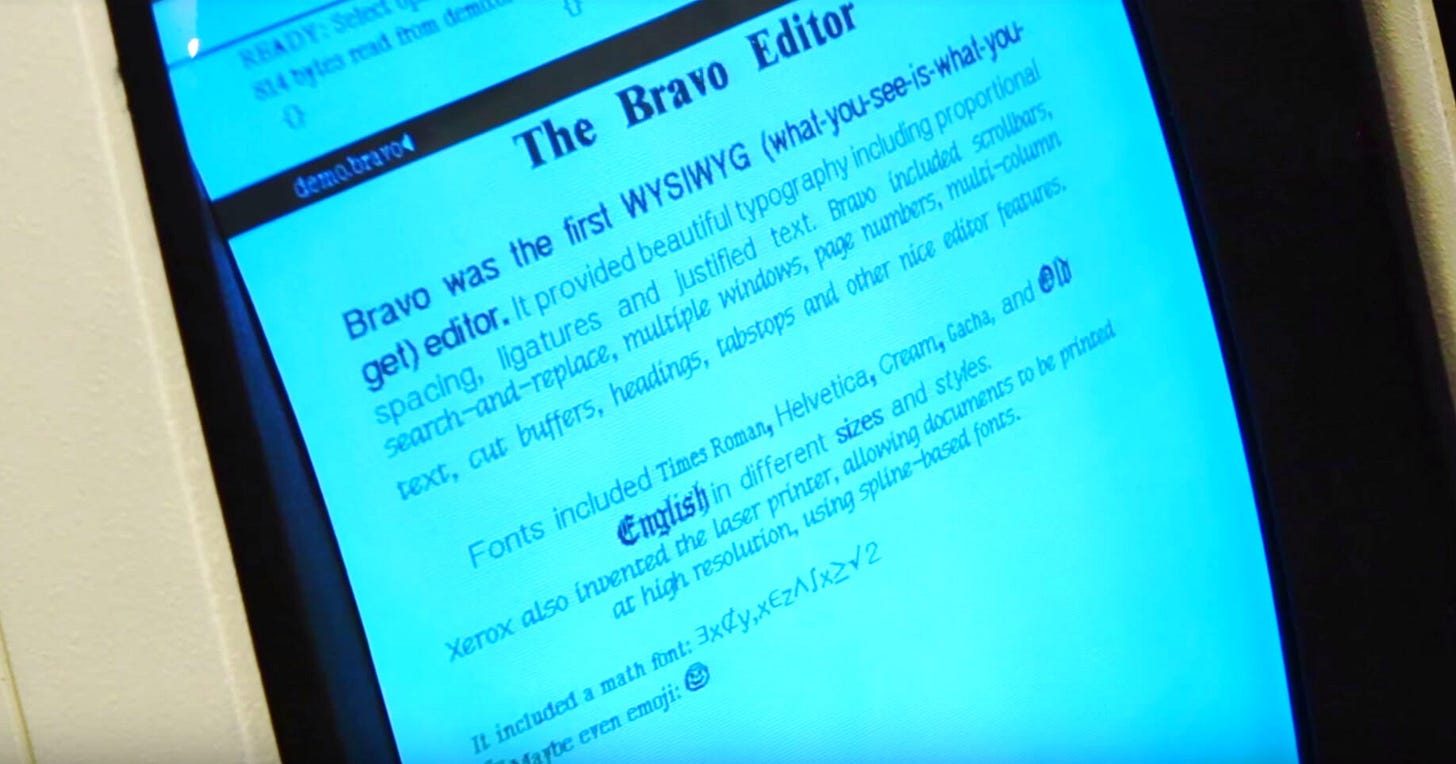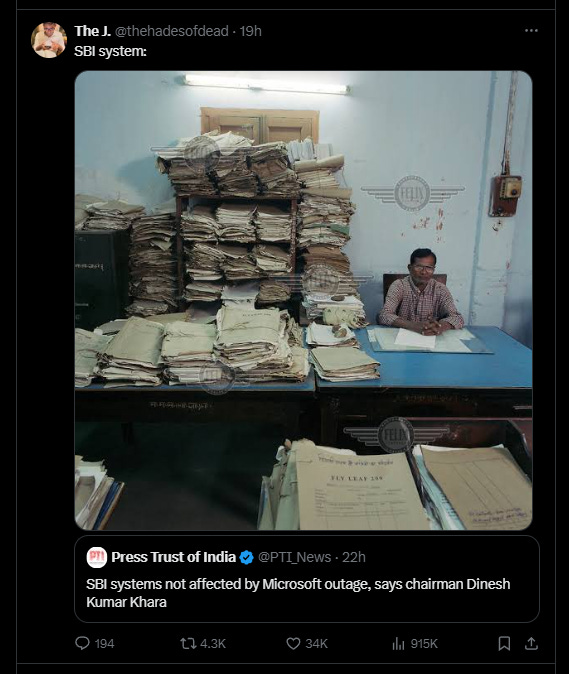I’m going to try something different with Things of Internet once in a while. Rather than just give you marketing case studies and a bunch of updates, I’m going to make an effort to dive deeper into one topic. We kick that off today with a dive into one company - one research lab, rather - who has played a pivotal role in shaping modern tech. The only thing they did better than come up with great innovations is, sadly, squander all of it. No seriously, they were amazing squanderers. “Hey Steve Jobs come look at this cool idea we have but no idea what to do with” level squadering.
Let’s take a walk around Xerox PARC.
Where it began
You know what Xerox is. They pretty much invented paper photocopying. They started life in 1906 doing completely different things, before an internal invention ended up revolutionising their businesss, and a lot else. Up to the 70s, the company was minting money as capitalism, processes, globalisation and paperwork all grew. They were a monopoly, and they had a crapton of moolah in the bank.
So much so that in 1970 the Rocester-based behemoth bankrolled a research centre at the other end of the country, Palo Alto. Hence Palo Alto Research Center (PARC) was set up to find ways of diversifying the business beyond photocopying. The idea was to attract top scientists and give them an environment to come up with crazy ideas without feeling commercial pressure. It was a visionary idea, really.
Scientists were treated like royalty - generous budgets, personal space, creative freedom, and yes even bean bags:
Although bean bag chairs are whimsical, their placement in this lounge had a serious intent. Light-weight and easy to move into any configuration, their purpose was to invite collaboration. No need to move desks and tables or lug chairs. Just pick up the bean bag, plop it down where you need it, and get to brainstorming.
In an era when massage chairs and nap cubicles are familiar furniture at many tech offices, a humble bean bag chair might not sound so exciting. But in the 1970s, it was truly revolutionary—a clear departure from the buttoned-up formality of office culture at the time.
Creative freedom and bean bags. You can already see this in today’s tech giants. But of course, PARC gave the world more than just informal office seating.
Refining Object Oriented Programming
If you’re not a programmer, you might wonder what that phrase is, or at least it’ll bring back some C++ trauma from 11th standard. But let’s just say scientists at PARC refined a form of programming that would significantly change the field in the next few years.
Laser Printing
A XEROX optical engineer with the superhero-real-life-person-name of Gary Starkweather used a laser beam to create an image on a laser drum. Boom, the laser printer was invented. 7 years later, Xerox would release the wildly successful Xerox 9700 which could print 120 pages a minute. This is what it looked like.
Now all seems good so far, but there’s a part in this story worth highlighting: Xerox execs weren’t initially too enthused about Starkweather’s invention, thinking it would cannibalise their existing technology. Phew, dodged that bullet and avoided a mistake, you’d say. Yes, but now it’s time to turn our attention to…
Graphical User Interface
The GUI was the most transformative thing PARC invented. The only thing is, it didn’t transform Xerox too much. The way we use computing devices today - icons, pointers, even touch - seem natural today but that wasn’t the case back in the late 1970s, when even Apple’s interfaces looked like this:
Then, scientists at PARC would go on and invent a cooler, more usable interface. Steve Jobs was hovering around Palo Alto at the time and impressed by what he heard about PARC. He would then go on to make one of the smartest investments ever in tech history - he negotiated a deal, offering Xerox a $1 million stake in Apple for access to PARC’s innovations. Xerox management - by now, probably fed up with the scientists’ antics (“You think a company like Xerox would ever make something called… a mouse?” one exec dismissed that device) said yeah whatever.
Jobs had unfettered access, and was blown away by the GUI. And two years later, it found its way into the Lisa and then the groundbreaking Mac. Computing was changed forever, Apple was changed forever. This is no secret, Jobs has said in many interviews how Xerox basically threw a good idea away:
Interviews with Jobs talking about PARC and its innovations reveal his true genius - the focus on product. He speaks about how Xerox failed because the product sensitivity got rotted out thanks to complacency. “There is no feeling in (management’s) hearts about the consumer”, he would lament.
Oh well, at least Xerox’s management had that $1m in Apple Stock, right? That would be worth $150 billion today. So that’s good right?
Wrong. They sold it before Apple even IPOed, for $1.2m.
No wonder Xerox management was called “tonerheads” by PARC scientists.
They also missed the bus on personal computing
It would be painful enough to miss the boat on one transformative piece of tech, but PARC also came up with a pretty cool personal computer called Alto. Except it was priced 10 times more than a comparable IBM one, so it went nowhere. Just see this ad to see how ahead of the times the thinking was (this was pre-Apple’s Lisa BTW):
BTW for all these videos - you should see the comments. Old Xeroxers lamenting about how management were so myopic, how Xerox should be a huge company today if it paid attention to anything, comparisons with Kodak…
Let’s stop the sob stories for a while and see what else Xerox PARC did invent, even if they didn’t necessarily profit a lot from it:
Ethernet
The cable connecting your computer to the internet (or at least, what goes into your Wifi router)? Bob Metcalfe and David Boggs from Xerox PARC. Here is one instance where a failure to commercialise didn’t come from management myopia but scientific munifiscence - they chose to give the tech away as an open standard. Metcalfe did go on to found 3Com, a company that would commercialise the tech so things didn’t end that badly for him. He would also come up with the concept of Metcalfe’s Law which is a nerdy way of saying - the more users on a platform, the more useful it is for everyone else.
And there was a lot lot more. Let’s go through some, quick.
The Bravo Editor - the first What-You-See-Is-What-You-Get text editor. Yes, before there was MS Word and Google Docs, there was Bravo. One of the scientists who worked on Bravo, incidentally, went on to work on Word at Microsoft. Bravo was 1974, Word was 1983. Imagine that, a whole decade apart.
PARCtab - well before the iPad and smartphones, there was this. 1992.
The Xerox Notetaker - In many ways, the first laptop. The first computer to be used in a commercial flight. 1978. Nineteen seventy eight.
The mouse - well, sort of. It was actually invented at Stanford Research Institute (SRI) but PARC refined it and integrated it with their GUI system and Alto computers. And you know what happened to those. As for the mouse, Apple popularised… Ok, ok.
And that’s not all. PARC led to advancements in e-paper, ubiquitous computing (the grandpa of IoT), semiconductor development, and lots more.
How it ended
It’s sometimes painful to read stories about PARC. But it ended in quite the poetic way - Xerox just donated the lab off to SRI (the original creators of the mouse and no research slouches themselves - playing key roles in the invention of the internet, voice recognition systems, ATMs, robotics and more).
PS: The idea for this article came about when I came across a tribute to Lynn Conway, a PARC engineer who passed away recently. In that way too - female representation, progressive ideals - PARC was a pioneer too.
And that’s a little bit about Xerox’s PARC. Now you have something to impress your friends with during dinners and drinks!
BTW I shouldn’t paint Xerox as a dinosaur
Far from it. Squander opportunities they did, but they also did invent… well, xerography which transformed business, they should get kudos for that. But even later, they would invent OCR technology (which enabled machines to read and convert different types of documents into editable/searchable data) and DocuTech (a system which helped create the print-on-demand industry).
Plus, even before PARC, their expensive machines were not sold as much as ‘subscribed to’ - there were rental models for their huge photocopiers with tickers that would track how many copies were done. Heck, you might remember the Xerox / technician scenes from Mad Men!
So yes, Xerox in many ways have transformed our lives.
Just thank goodness Steve Jobs was at the right place at the right time, too!
LOL: Maybe digital transformation is not always a good thing!
Tell me what you thought about this format for the newsletter. I had a ton of fun doing this piece. And there are many more deepdives planned.
Till next week,
Chuck







